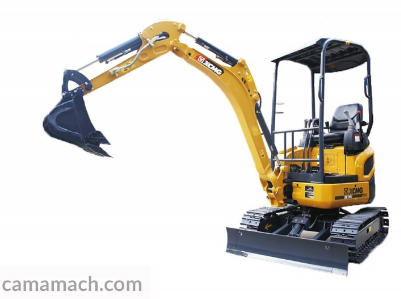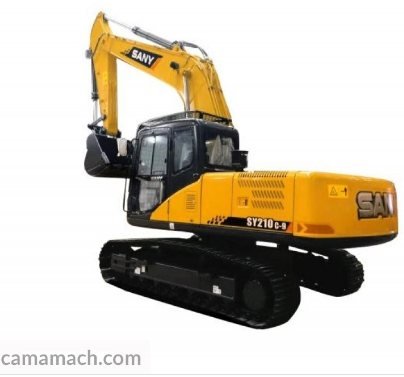Mini, Medium, and large excavators have a similar general function- they all dig up the earth. Still, they have differences in size, making each machine unique towards its specific job. Choosing the right construction equipment is essential for any project, which is why we will explain and compare the mini, medium, and large excavators.
Mini Excavator
The mini excavator is a heavy construction machine built to dig up the earth. It has an operating weight of 1795kg and a bucket weight capacity of 0.43 m3. Also, it has a compact size which helps to maximize the little available space.

Medium Excavator
A medium excavator is a heavy construction machine similar to the mini excavator but has differing characteristics. The medium excavator has an operating weight between 14400 kg to 35500kg and a bucket capacity of 0.4 to 1.5 m3.

Large Excavator
The giant excavator is a heavy construction machine similar to mini and medium excavators but has a few differing characteristics. Their operation weight ranges from 46100 kg to 87100 kg and has a bucket capacity of 2.1m3 to 6.0m3. They are suitable for extensive commercial construction activities.

Differences
1. Size
The mini excavator is a small-size excavator, while a medium excavator is a medium-size excavator. The large excavator is a giant excavator. Each of the three excavators is different in size, making them unique in the type of construction projects they can handle.
2. Digging force and depth
The small excavator has a digging force of 16kN and a depth between 2290mm to 4020 mm. The medium excavator features a digging force of 85 kN to 263kN and a digging depth of 5538mm to 7423 mm. On the other hand, the large excavator has a digging force of 284kN to 480kN and a digging depth of 7337 mm.
3. Space
The mini excavator is compact in shape, which makes it suitable for small available space. The medium excavator takes more space than the mini excavator but not as much as the large excavator. The giant excavator has large-bodied characteristics, which make it need ample storage and operating area.
Overview
Although mini, medium, and large excavators are similar in their functionality, they have different characteristics that make each machine ideal in different specific construction operations scenarios.
Mini Excavator
- It is the smallest excavation equipment you can buy.
- It is mainly used for small-scale farm and construction activities because its compact size helps to maximize the little available space.
- The excavator is engine-powered and requires an energy input of about 9.8kW, making it efficient for small construction projects.
- The excavator has a digging depth of 2290 mm to 4020 mm, suitable for small commercial construction projects.
- Finally, the mini-excavator has an operating weight of 1795kg to 7920 kg.
Medium Excavator
- The medium excavator is more prominent than the mini excavator, making it suitable for medium commercial construction projects.
- The excavator has an operating weight of 14400 kg to 36800 kg.
- Besides, the bucket capacity ranges from 0.4m3 to 1.8m3, making it suitable for medium construction projects.
- The medium excavator has a digging depth of 5538mm to 7423mm.
- Finally, the medium excavator has a digging height of 8641mm to 10445 mm, making it efficient for medium construction projects.
Large Excavator
- The giant excavator is the largest excavator you can buy and hence efficient for more significant construction projects.
- It features the largest bucket capacity ranging between 2.1m3 to 6.0m3.
- The giant excavator provides the maximum digging length compared to the mini and medium excavators.
- Also, the large excavator is very efficient in operations, achieving a rotation speed up to 1800r/m.
- Finally, the large excavator comes with durable parts and meets mining application requirements.
Mini, Medium, or Large Excavator-which construction machine is better for your project?
It is essential to consider your project’s scope and details when choosing the right construction equipment for your construction tasks. The mini, medium, and large excavators provide the function of digging up the earth, but one can be more practical than the others depending on the specifics of your projects.
The mini excavator would be ideal for small commercial construction projects because of its compact size. The medium excavator is suitable for medium construction projects because of its medium size and bucket capacity. The giant excavator fits sizeable commercial construction projects because it features the largest bucket capacity, digging height, and depth.
Wondering Where to Find Mini, Medium, and Large Excavators for Sale?
Whether you are interested in the mini, medium, large excavators or are still unsure which machine is more suitable for you, feel free to ask an expert at Camamach! We have years of experience in the heavy construction machinery industry and are happy to help others find the best construction equipment based on their specific needs. Contact us, and we can make professional recommendations based on your site plans and requirements.
How can we help you with your equipment/parts requirements?
✅ Are you a company of 11 - 50 people?
✅ Do you spend too much time finding the right equipment manufacturers?
✅ Unsure if you will get the right equipment?
✅ Unsure if you will get the right after sales and spare parts?
If your answer is YES, Contact Us Now for a FREE Consultation





